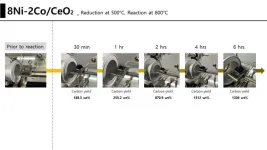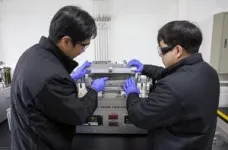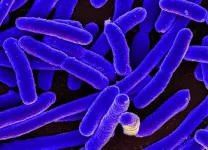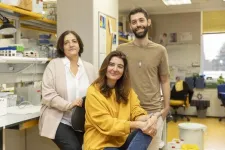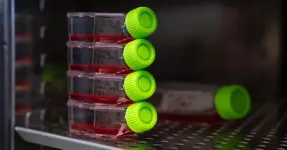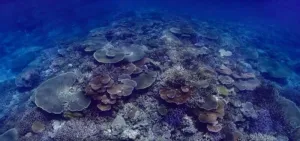(Press-News.org) Dr. Woohyun Kim's research team from the Hydrogen Research Department at the Korea Institute of Energy Research (KIER) has successfully developed an innovative nickel-cobalt composite catalyst that can accelerate the production and commercialization of turquoise hydrogen.*
*Turquoise Hydrogen: A technology that produces hydrogen and carbon by decomposing hydrocarbons such as methane (CH₄) (CH₄ → C + 2H₂). Unlike gray hydrogen, the most widely used hydrogen production technology, turquoise hydrogen generates no carbon dioxide emissions during the production process.
In 2021, the Korean government announced the "First Hydrogen Economy Implementation Plan," aiming to supply 28 million tons of clean hydrogen domestically by 2050. Consequently, recent hydrogen research has been actively focusing on production methods that can reduce greenhouse gas emissions.
*Clean Hydrogen: Hydrogen that contributes to carbon neutrality by maintaining greenhouse gas emissions below a certain threshold during production. In the Republic of Korea, hydrogen is classified as clean if the total greenhouse gas emissions during the production of 1 kg of hydrogen are 4 kg or less.
Turquoise hydrogen, a type of clean hydrogen, is a technology that produces hydrogen and solid carbon by thermally decomposing methane (CH₄), the main component of natural gas. While it uses fossil fuels as the source, it does not emit carbon dioxide during the production process. As a result, it eliminates the need for additional carbon dioxide capture and storage, enabling the production of clean hydrogen.
However, the commercialization of turquoise hydrogen technology has been delayed due to challenges in supplying the heat required for the reaction. Catalytic Turquoise hydrogen production typically uses nickel- and iron-based catalysts, which exhibit low activity at lower temperatures, requiring the maintenance of high temperatures around 900°C for stable production. Additionally, the lack of viable applications for the carbon produced alongside hydrogen during the reaction remains an issue that needs to be addressed.
The research team successfully developed an innovative catalyst by adding cobalt to a nickel-based catalyst to overcome the limitations of existing catalysts. Compared to previously studied catalysts, the newly developed catalyst enables hydrogen production with higher efficiency at significantly lower temperature ranges.
Cobalt plays a key role in enhancing electrical activity and improving durability when used as a catalyst in the production of carbon-based materials. Building on this property, the research team added cobalt to a nickel-based catalyst and conducted experiments to optimize its composition and ensure reproducibility. As a result, they found that a composition containing 8% nickel and 2% cobalt achieved the highest hydrogen production efficiency.
The developed catalyst demonstrated over 50% higher hydrogen productivity compared to previously developed catalysts, based on initial activity measured within the first 30 minutes, even at a low temperature of 600°C. Additionally, while the initial activity of existing catalysts is maintained for about 90 minutes, the new catalyst extends this duration by 60%, maintaining its initial activity for approximately 150 minutes.
*Initial Activity: Refers to the active state observed immediately after a catalytic reaction begins and serves as a primary indicator in evaluating the performance of catalyst candidates. A catalyst is considered superior if it exhibits high initial activity and a prolonged maintenance time of that activity.
The team also observed the formation of carbon nanotubes on the catalyst surface after the reaction. Carbon nanotubes are widely used as electrode materials for secondary batteries and as construction materials, among other applications. This finding highlights the potential to produce high-value-added carbon materials alongside hydrogen production.
Dr. Woohyun Kim, the head of the research, stated, “This research demonstrates a groundbreaking outcome, enabling the simultaneous production of hydrogen and carbon nanotubes, achieving both productivity and economic efficiency.” He added, “We plan to further research mass-production technology utilizing the developed catalyst, conduct performance evaluations, and secure core material technology and reaction system design capabilities.”
This research was conducted with support from the Korea Institute of Energy Research’s Research Program and was published in the November 2024 issue of ‘Fuel Processing Technology (Impact Factor: 7.2)’, a globally renowned journal in the field of chemical engineering.
END
KIER unveils catalyst innovations for sustainable turquoise hydrogen solutions
Enables hydrogen production at 300°C lower than conventional thermal methane cracking processes, improving hydrogen productivity by 50%
2024-11-29
ELSE PRESS RELEASES FROM THIS DATE:
Bacteria ditch tags to dodge antibiotics
2024-11-29
Bacteria modify their ribosomes when exposed to widely used antibiotics, according to research published today in Nature Communications. The subtle changes might be enough to alter the binding site of drug targets and constitute a possible new mechanism of antibiotic resistance.
Escherichia coli is a common bacterium which is often harmless but can cause serious infections. The researchers exposed E. coli to streptomycin and kasugamycin, two drugs which treat bacterial infections. Streptomycin has been a staple in treating tuberculosis and other infections since the 1940s, while kasugamycin is less known but crucial in agricultural settings ...
New insights in plant response to high temperatures and drought
2024-11-29
Ghent, 29 November 2024 – We are increasingly confronted with the impacts of climate change, with failed harvests being only one example. Addressing these challenges requires multifaceted approaches, including making plants more resilient. An international research team led by researchers at VIB-UGent has unraveled how the opening and closing of stomata - tiny pores on leaves – is regulated in response to high temperatures and drought. These new insights, published in Nature Plants, pave the way for developing climate change-ready crops.
Global climate change affects more and more people, with extreme weather conditions ...
Strategies for safe and equitable access to water: a catalyst for global peace and security
2024-11-29
Water can be a catalyst for peace and security with a critical role in preventing conflicts and promoting cooperation among communities and nations - but only if managed equitably and sustainably, a new study reveals.
Experts have devised a blueprint to ensure safe, equitable and sustainable global access to clean water. The seven-point strategy will allow water challenges to be governed effectively so they do not create conflict when access is restricted or usage unfairly shared.
Publishing ...
CNIO opens up new research pathways against paediatric cancer Ewing sarcoma by discovering mechanisms that make it more aggressive
2024-11-29
Ewing sarcoma is a tumour of the bones and soft tissues that occurs in children and young people. A quarter of patients do not respond well to therapy.
The group led by Ana Losada, at Spain’s National Cancer Research Centre (CNIO), has discovered an alteration in the most aggressive cases that affects genes never previously related to this disease.
This finding expands the list of potential prognostic markers and therapeutic targets in the most aggressive cases of Ewing sarcoma.
The new research is published in EMBO Reports.
Ewing sarcoma is a tumour of the bones and soft tissues that occurs in children and young people. ...
Disease severity staging system for NOTCH3-associated small vessel disease, including CADASIL
2024-11-29
About The Study: The findings of this study suggest the NOTCH3-associated small vessel disease (NOTCH3-SVD) staging system will help to better harmonize NOTCH3-SVD and cerebral autosomal dominant arteriopathy with subcortical infarcts and leukoencephalopathy (CADASIL) cohort studies and registries; may improve individualized disease counseling, monitoring, and clinical management; and may facilitate patient stratification in clinical trials.
Corresponding Authors: To contact the corresponding ...
Satellite evidence bolsters case that climate change caused mass elephant die-off
2024-11-29
A new study led by King’s College London has provided further evidence that the deaths of 350 African elephants in Botswana during 2020 were the result of drinking from water holes where toxic algae populations had exploded due to climate change.
The lead author of the report says their analysis shows animals were very likely poisoned by watering holes where toxic blooms of blue-green algae, or cyanobacteria, had developed after a very wet year followed a very dry one.
Davide Lomeo, a PhD student in the Department of Geography at King’s College London and co-supervised by Plymouth Marine Laboratory (PML) and ...
Unique killer whale pod may have acquired special skills to hunt the world’s largest fish
2024-11-29
Killer whales can feed on marine mammals, turtles, and fish. In the Gulf of California, a pod might have picked up new skills that help them hunt whale sharks – the world’s largest fish, growing up to 18 meters long.
Whale sharks feed at aggregation sites in the Gulf of California, sometimes while they are still young and smaller. During this life-stage, they are more vulnerable to predation, and anecdotal evidence suggests orcas could be hunting them. Now, researchers in Mexico have reported four separate hunting events.
“We show how orcas displayed a collaboratively hunting technique on whale sharks, characterized by ...
Emory-led Lancet review highlights racial disparities in sudden cardiac arrest and death among athletes
2024-11-29
UNDER STRICT EMBARGO UNTIL 6:30 PM November 28, 2024:
A recent major review of data published by the Lancet and led by Emory sports cardiologist Jonathan Kim, MD, shows that Black athletes are approximately five times more likely to experience sudden cardiac arrest (SCA) and sudden cardiac death (SCD) compared to White athletes, despite some evidence of a decline in rates of SCD overall. SCA and SCD have historically been a leading cause of mortality among athletes, particularly those involved in high-intensity sports.
The disparities in SCA/D rates highlights the need for increased research into the social determinants of health in younger athletes, a topic that remains ...
A new approach to predicting malaria drug resistance
2024-11-28
Researchers at University of California San Diego analyzed the genomes of hundreds of malaria parasites to determine which genetic variants are most likely to confer drug resistance. The findings, published in Science, could help scientists use machine learning to predict antimalarial drug resistance and more effectively prioritize the most promising experimental treatments for further development. The approach could also help predict treatment resistance in other infectious diseases, and even cancer.
“A lot of drug resistance research can only look at one chemical agent at a time, but what we’ve been able to do here is create a roadmap ...
Coral adaptation unlikely to keep pace with global warming
2024-11-28
Coral adaptation to ocean warming and marine heatwaves will likely be overwhelmed without rapid reductions of global greenhouse gas emissions, according to an international team of scientists.
Their study, led by Dr. Liam Lachs of Newcastle University, reveals that coral heat tolerance adaptation via natural selection could keep pace with ocean warming, but only if Paris Agreement commitments are realised, limiting global warming to two degrees Celsius.
“The reality is that marine heatwaves are triggering mass coral bleaching mortality events across the world’s shallow tropical reef ecosystems, and the increasing frequency and intensity of these events ...
LAST 30 PRESS RELEASES:
What causes some people’s gut microbes to produce high alcohol levels?
Global study reveals widespread burning of plastic for heating and cooking
MIT study shows pills that communicate from the stomach could improve medication adherence
Searching for the centromere: diversity in pathways key for cell division
Behind nature’s blueprints
Researchers search for why some people’s gut microbes produce high alcohol levels
Researchers find promising new way to boost the immune response to cancer
Coffee as a staining agent substitute in electron microscopy
Revealing the diversity of olfactory receptors in hagfish and its implications for early vertebrate evolution
Development of an ultrasonic sensor capable of cuffless, non-invasive blood pressure measurement
Longer treatment with medications for opioid use disorder is associated with greater probability of survival
Strategy over morality can help conservation campaigns reduce ivory demand, research shows
Rising temperatures reshape microbial carbon cycling during animal carcass decomposition in water
Achieving ultra-low-power explosive jumps via locust bio-hybrid muscle actuators
Plant-derived phenolic acids revive the power of tetracycline against drug-resistant bacteria
Cooperation: A costly affair in bacterial social behaviour?
Viruses in wastewater: Silent drivers of pollution removal and antibiotic resistance
Sub-iethal water disinfection may accelerate the spread of antibiotic resistance
Three in four new Australian moms struggle with body image
Post-stroke injection protects the brain in preclinical study
Cardiovascular risk score predicts multiple eye diseases
Health: estimated one in ten British adults used or interested in GLP-1 medications for weight loss
Exercise to treat depression yields similar results to therapy
Whooping cough vaccination for pregnant women strengthens babies’ immune system
Dramatic decline in new cases of orphanhood in Uganda driven by HIV treatment and prevention programs
Stopping weight loss drugs linked to weight regain and reversal of heart health markers
Higher intake of food preservatives linked to increased cancer risk
Mass General Brigham–developed cholera vaccine completes phase 1 trial
First experimental validation of a “150-year-old chemical common sense” direct visualization of the molecular structural changes in the ultrafast anthracene [4+4] photocycloaddition reaction
Lack of support for people on weight loss drugs leaves them vulnerable to nutritional deficiencies, say experts
[Press-News.org] KIER unveils catalyst innovations for sustainable turquoise hydrogen solutionsEnables hydrogen production at 300°C lower than conventional thermal methane cracking processes, improving hydrogen productivity by 50%
